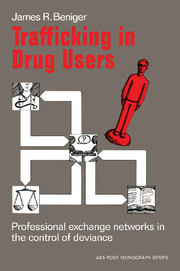Book contents
- Frontmatter
- Contents
- Acknowledgments
- Introduction
- 1 The emergence of the “drug problem”: social change versus social control
- 2 Control systems from exchange in networks: toward a synthesis of system and action theory
- 3 Stratification in information and referral exchange
- 4 Exchange relationships in social-control systems
- 5 The social system: boundary maintenance and hierarchical control
- 6 Summary: the control system in context
- Appendix A The data set
- Appendix B Subgroup sampling and estimated-density spaces (EDS)
- Notes
- Bibliography
- Name index
- Subject index
4 - Exchange relationships in social-control systems
Published online by Cambridge University Press: 07 May 2010
- Frontmatter
- Contents
- Acknowledgments
- Introduction
- 1 The emergence of the “drug problem”: social change versus social control
- 2 Control systems from exchange in networks: toward a synthesis of system and action theory
- 3 Stratification in information and referral exchange
- 4 Exchange relationships in social-control systems
- 5 The social system: boundary maintenance and hierarchical control
- 6 Summary: the control system in context
- Appendix A The data set
- Appendix B Subgroup sampling and estimated-density spaces (EDS)
- Notes
- Bibliography
- Name index
- Subject index
Summary
The concept of system in the social sciences might be traced back at least as far as the discussions of individual homeostatic processes in L. J. Henderson's The Fitness of the Environment (1913), a work that owes much to Pareto's cyclical theories (Henderson 1935); Henderson's work is acknowledged by Wiener in his text establishing the modern field of cybernetics (Wiener 1948, p. 115). Bertalanffy, an early proselyte of “general system theory,” cites Lotka's classic Elements of Physical Biology (1925) as the first work to deal with system theory in full generality (Bertalanffy 1968, p. 11). Another foreshadowing can be found in Whitehead's philosophy of “organic mechanism” (Whitehead 1925); as late as the mid-193Os, Parsons credited Whitehead with “the most extensive analysis of the general concept of the ‘organic’ which is known to the author” (Parsons 1937, p. 32). Other biological precursors include Bernard's functional view of physiological processes (Bernard 1927) and Cannon's further work on homeostasis (Cannon 1929, 1932).
Renewed interest in general systems grew out of developments in servomechanisms, information and communication theory, and computers during and immediately following World War II. Instrumental in these developments were two publications, both issued in 1948, which founded two new areas of systems studies: cybernetics, formally introduced in Wiener's book by that title (Wiener 1948), and further popularized by him (Wiener 1950); and information theory, established in a paper by Shannon (1948), and popularized in a text by Shannon and Weaver (1949).
Information
- Type
- Chapter
- Information
- Trafficking in Drug UsersProfessional Exchange Networks in the Control of Deviance, pp. 93 - 138Publisher: Cambridge University PressPrint publication year: 1984
